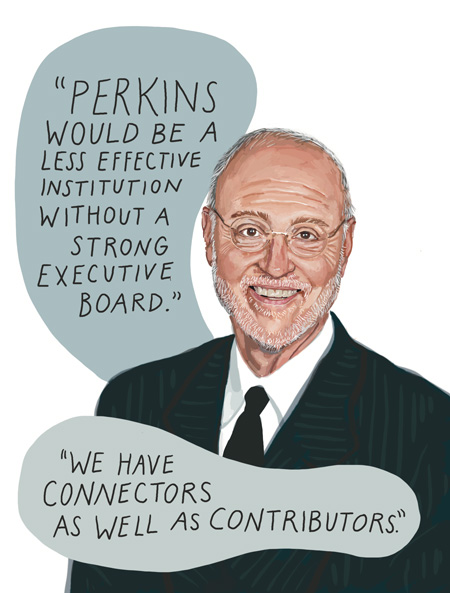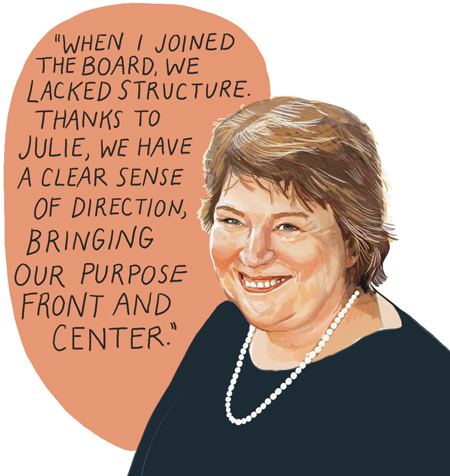
John Martin, Th.D., Ph.D., Director of Development. Portrait by Martha Park
Nearly half of the schools accredited by the Association of Theological Schools are now embedded within larger academic institutions. While the benefits of association are many, these schools also confront the challenges of competing for resources and recognition with other, usually larger, colleges and schools within the larger university.
Striking the balance between integration and sustaining a distinctive identity is a constant and delicate balancing act, leaders acknowledge.
Some schools have found the creation of robust advisory boards to be a strategic solution for sustaining identity and navigating within a larger institution. Structured effectively, an advisory board can be instrumental in advancing the mission vitality and identity of an embedded theological school.
The Executive Board at Perkins School of Theology at Southern Methodist University (SMU) is one such board, and its members consider its role to be crucial for successfully navigating institutional co-dependency.
According to John Martin, Th.D., Ph.D., director of development and external affairs at Perkins, “Theology was one of the main courses of study when (SMU) started as an institution in 1915. The school’s history is intertwined with the larger story of SMU itself.”
Perkins is the University’s oldest graduate professional school. It held its first classes in 1914, and is today the smallest of the eight SMU schools. Despite its size, Perkins is highly valued within the broader university, Martin says, and maintaining relevance and distinction requires a deeply committed school leadership team.
Enter Perkins’ Executive Board, a 45-member advisory body appointed by the university president in consultation with the Executive Board chair and the dean or director, and approved by the University’s Board of Trustees. The board provides advice and counsel; supports linkages among faculty, students and the broader church community; aids in faculty recruitment and development; monitors performance of the School; and assists in networking locally, regionally and nationally.
The Rev. Katherine Glaze Lyle, an SMU alumna with a B.A., M.A. and M.Div. from Perkins, is the co-vice chair of the Executive Board.
“Perkins has a big place in SMU’s history,” she says, “and I believe Gerald (SMU President R. Gerald Turner,) recognizes that. We see his commitment and support in many ways.”
Building a strong board is an integral part of the process. Perkins’ development and external affairs office partners with SMU in the identification of prospective board members, who undergo a thorough vetting through the university’s standardized legal process. This deliberate selection specifically targets individuals with industry influence, successful alumni status, and a strong connection to the school’s mission.
A distinctive feature of Perkins’ advisory board lies in its members’ diversity and engagement, with their experience and expertise closely aligned with Perkins’ mission, Martin says.
“We have connectors as well as contributors,” notes Martin. “While we need people of means, they must also have a deep relationship with the Church.”
Driving this dynamic group is Perkins’ board chair, Julie Yarbrough. An active investment manager and financial planner, Yarbrough has extensive board experience as past chair of the fiduciary Board of Directors of Methodist Health System in Dallas and as a member of the board of Texas Methodist Foundation. In 2006, her involvement in a construction and facilities improvement project helped shape Perkins’ future vision; a year later, she joined the executive board and has served as its chair since 2022.

The Rev. Katherine Glaze Lyle, co-Vice Chair. Portrait by Martha Park
Guided and inspired by her leadership, Lyle says, Perkins’ board has adopted stronger a sense of structure, professionalism, and purpose. “When I joined the board, we lacked structure,” she recalls. “Thanks to Julie, we have a clear sense of direction, bringing our purpose front and center.”
Martin agrees. “Julie has truly revolutionized the professionalism of our executive board meetings, gaining recognition and attention across campus. Our meetings are now well-structured with thoughtful agendas, providing engaging discussions for the team.”
He believes that Yarbrough’s enthusiasm, strong faith, and professional attitude have brought a clear and defined purpose to the board’s role and improved the school’s visibility on SMU’s main campus, known as the Hilltop.
“In the last two years, our collective vision for the executive board has focused on optimizing the group’s duties as outlined in SMU’s bylaws,” says Yarbrough. This includes advising and counseling the dean, creating connections with Perkins’ constituent groups, supporting faculty recruitment and development, collaborating on advancement office programs, participating in community outreach efforts, and monitoring the school’s performance and academic units.
“Perkins would be a less effective institution without a strong executive board,” Martin says. “The board members serve as encouragers, genuinely seeking what’s best for Perkins.”
Lyle adds that Yarbrough’s sincere and personal approach toward her fellow board members and the university community advances the school’s connection with the SMU community. In turn, SMU has become a committed advocate for Perkins and its historic place in the University’s academic life.
Creating a recognized presence on campus despite the school’s small footprint has been a goal for Perkins. Board members have assisted in SMU capital campaigns and are credited as being among SMU’s best ambassadors.
The school also serves as the home of two major entities on campus: Bridwell Library and Perkins Chapel. Both are administratively and missionally connected to the university’s academic life and mission.
Yarbrough also is credited with expanding the board’s role beyond its advisory duties. Under her leadership, a more robust committee model has been established. The Executive Board also hosts events for SMU and surrounding communities, with notable guest speakers on topics such as faith in business and private faith in public life.
By implementing these strategies, Perkins is trying to best leverage its high-powered executive board as a means to maintain its distinctiveness but also to enhance its overall standing among the academic units within the larger institution.
“Our goal as board members will always be driving the excellence of Perkins,” says Yarbrough.
Lyle agrees. “(Perkins) holds a substantial historical significance for both SMU and the broader Dallas community.
“Perkins is where SMU’s mission and values align.”




























